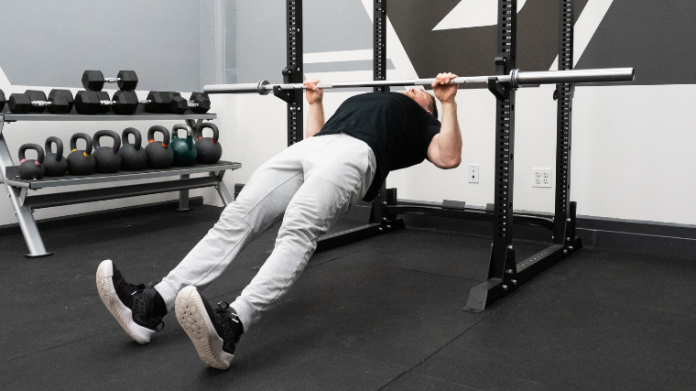In one particularly promising trial of 30 sedentary women, signs of worry and anxiety showed remission in 60 percent of the participants, compared with 40 percent for the aerobic training group. (7)
While these studies are definitely promising, they’re not a blanket recommendation and do not constitute medical advice. Speak with a medical practitioner first if you think you may be experiencing the symptoms of depression.
Practical Application
- Hitting the gym to improve your mood will only work if you actually like what you’re doing. Make sure you’re on a routine that makes lifting weights fun and not a chore of its own.
[Related: Three Steps to Better Time Management For Strength Athletes]
Fewer Strokes
Physical inactivity has been listed by the famous Interstroke study as one of the five key risk factors responsible for 80 percent of the world’s strokes, and in this case, more is better. (8)
A meta-analysis of a whopping 23 studies concluded that the risk reduction in adults who practiced regular physical exercise was as high as 27 percent. (9)
Much of this literature doesn’t differentiate between aerobic and resistance training, but while aerobic definitely has its place, strength – in particular, grip strength – has been strongly correlated with stroke risk. (10)
Practical Application
- Like many other preventative benefits of weight lifting, you can’t really target stroke risk reduction through training. For general well-being, find a balanced routine that includes some form of cardio as well, possibly at the end of your session.
Improved Posture
From a young age, most of us were told to “stand up straight” or “quit slouching.” While we may have chalked this up to motherly nagging at the time, it turns out that these jabs are rooted in tangible science that backs resistance training as well.
Lifting weights helps develop and strengthen the core, spine, hips, and shoulders musculature, which are all heavily dedicated to maintaining correct posture. Aside from making you look a little taller when you enter a room, improved posture has been regularly linked to better health outcomes regarding back pain. (11)
A lesser-known perk, however, is the effect of good posture on cognition. Some literature argues that people who stand — properly, of course — instead of sitting or slouching can have better thought patterning and cognition skills, helping them perform better in the workplace. (12)
Practical Application
- If you want to give extra attention to your posture, incorporate posterior chain and upper back movements like Romanian deadlifts, back extensions, or your favorite row variation.
Better Relationships
We’re not saying that hitting the gym will help you find the love of your life — although a workout can be a good first date idea. Concerning interpersonal relationships in general, some science suggests physical activity performed with coworkers can improve quality of life and reduce stress in the workplace. (13)
We can’t guarantee that doing a partner ab workout will prevent you from being irritated by an insufferable colleague, but getting some group-based activity together may help ease tensions or perceived workload both in and out of the office. (14)
Practical Application
- Group training sessions like those commonly found in CrossFit are great for hitting the iron with partners or partners. Alternatively, having a workout buddy with you in the gym to serve as a spotter or motivator might benefit your actual training more than you think.
Better Sleep Quality
You probably don’t need someone to tell you that getting a good night’s sleep is essential for way more than just crushing it in the gym. Being consistently well-rested improves every aspect of your life, not just your training.
Fortunately, lifting weights is one of the most thoroughly-backed methods of improving rest quality for just about everyone. (15) For those who rely on a pill or potion to get some shut-eye, research suggests that consistent resistance training may suitably replace the medication for inducing sleep long-term. (16)
Practical Application
- Get on a good resistance training program if you find yourself lacking in healthy sleep patterns. Be careful when you decide to hit the gym, though — training close to your normal bedtime can actually inhibit your body’s ability to relax, especially if you use a pre-workout supplement.
[Related: 3 Ways to Use Kettlebells for Active Recovery]
Wrapping Up
Many of the conditions we just mentioned are considered consequences of the aging process. Strength training’s ability to prevent, combat, and reverse some of their effects is why lifting weights can literally make your body younger. (17) That said, if you have a serious condition, always consult with your doctor regarding treatment.
It can be easy to stumble upon a routine guaranteed to give you a boulder chest or cannonball-sized shoulders and conflate resistance training with vanity. As it turns out, lifting does just as much — if not more — for the inside of your body as it does the outside.
References
- Herold, F., Törpel, A., Schega, L. et al. (2019) Functional and/or structural brain changes in response to resistance exercises and resistance training lead to cognitive improvements – a systematic review. Eur Rev Aging Phys Act 16(10).
- Yarrow, J. F., White, L. J., McCoy, S. C., & Borst, S. E. (2010). Training augments resistance exercise induced elevation of circulating brain derived neurotrophic factor (BDNF). Neuroscience letters, 479(2), 161–165.
- Prabhakaran, B., Dowling, E. A., Branch, J. D., Swain, D. P., & Leutholtz, B. C. (1999). Effect of 14 weeks of resistance training on lipid profile and body fat percentage in premenopausal women. British journal of sports medicine, 33(3), 190–195.
- Powell-Wiley et al. (2021) Obesity and Cardiovascular Disease: A Scientific Statement From the American Heart Association. American Heart Association.
- Liu, D., Sartor, M. A., Nader, G. A., Gutmann, L., Treutelaar, M. K., Pistilli, E. E., Iglayreger, H. B., Burant, C. F., Hoffman, E. P., & Gordon, P. M. (2010). Skeletal muscle gene expression in response to resistance exercise: sex specific regulation. BMC genomics, 11, 659.
- O’Connor PJ, Herring MP, Caravalho A. (2010) Mental Health Benefits of Strength Training in Adults. American Journal of Lifestyle Medicine 4(5):377-396.
- Melville A. N. (2011) Resistance Training Improves Generalized Anxiety Disorder. American College of Sports Medicine.
- O’Donnell M. et al. (2010) Risk factors for ischaemic and intracerebral haemorrhagic stroke in 22 countries (the INTERSTROKE study): a case-control study. The Lancet 376(9735).
- Lee, C. D., Folsom, A. R., & Blair, S. N. (2003). Physical activity and stroke risk: a meta-analysis. Stroke, 34(10), 2475–2481.
- Leong et al. (2015) Prognostic value of grip strength: findings from the Prospective Urban Rural Epidemiology (PURE) study. The Lancet 386(9990).
- Nowotny, J., Nowotny-Czupryna, O., Brzęk, A., Kowalczyk, A., & Czupryna, K. (2011). Body posture and syndromes of back pain. Ortopedia, traumatologia, rehabilitacja, 13(1), 59–71.
- Smith, K.C., Davoli, C.C., Knapp, W.H. et al. (2019) Standing enhances cognitive control and alters visual search. Atten Percept Psychophys 81, 2320–2329.
- Jakobsen, M. D., Sundstrup, E., Brandt, M., & Andersen, L. L. (2017). Psychosocial benefits of workplace physical exercise: cluster randomized controlled trial. BMC public health, 17(1), 798.
- Jakobsen, M. D., Sundstrup, E., Brandt, M., Jay, K., Aagaard, P., & Andersen, L. L. (2015). Physical exercise at the workplace reduces perceived physical exertion during healthcare work: cluster randomized controlled trial. Scandinavian journal of public health, 43(7), 713–720.
- Kovacevic, A., Mavros, Y., Heisz, J. J., & Fiatarone Singh, M. A. (2018). The effect of resistance exercise on sleep: A systematic review of randomized controlled trials. Sleep medicine reviews, 39, 52–68.
- Yang, P. Y., Ho, K. H., Chen, H. C., & Chien, M. Y. (2012). Exercise training improves sleep quality in middle-aged and older adults with sleep problems: a systematic review. Journal of physiotherapy, 58(3), 157–163.
- Melov S, Tarnopolsky MA, Beckman K, Felkey K, Hubbard A (2007) Resistance Exercise Reverses Aging in Human Skeletal Muscle. PLoS ONE 2(5)

























